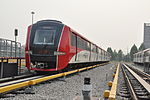Beijing Subway rolling stock
All Beijing Subway trains run on 1,435mm standard gauge rail and draw power from the 750 V DC third rail, except those on Lines 6 and 14, which use 1,500 V DC overhead wires.[1] Lines 6, 15, Fangshan, and Changping have a designed maximum service speed of 100 km/h (62 mph).[2] The Airport Line is linear motor driven with a designed maximum service speed of 110 km/h (68 mph)[3][4] All other Lines have a maximum service speed of 80 km/h (50 mph). Currently Lines 1, 2, 4, 5, 8, 9, 10, 13, 15, Batong, Daxing, Changping, Fangshan, Yanfang, and Yizhuang use 6 car B size trains. Initially, Lines Batong and 13 was originally used 4 car trains and now expanded into six.[5][6][7]
Manufacturers
From the subway's inception to 2003, all Beijing subway trains were manufactured by the Changchun Railway Vehicles Company Ltd., now a subsidiary of the China CNR Corporation. All rolling stock on Lines 2, 5, 6,[8] 9, 10, 13, 15, Yizhuang, Airport and some of Line 1, 14, 16, and Yanfang line stocks[3][9][10] are produced by CNR.[11] However, Qingdao Sifang Locomotive & Rolling Stock Co., Ltd., a subsidiary of China South Locomotive and Rolling Stock Corp. has recently produced rolling stock for the Beijing subway. CSR produced all the trains for Lines 4,[12][13] 8, Daxing,[13] Changping,[14] Daxing Airport Express and some of Line 1,[15] 14,[9][16][17], 16, and Yanfang Line.
The Beijing Subway Rolling Stock Equipment Co. Ltd., a wholly owned subsidiary of the Beijing Mass Transit Railway Operation Corp., provides local assemblage, maintenance and repair services. It has also made trains for line 7, Ba Tong, and Fangshan lines.
Models
First Generation
In the 1960s to mid-1970s, the Beijing Subway used DK2 and DK3 models made in Changchun. The DK stands for diandong keche or electrically-operated passenger car.[18] These models and their derivatives, the DK3G, DK20, DK16A, BD1 and BD2 are classified by the Beijing Subway as the first generation.[19] In recent decades, the Beijing Subway Rolling Stock Equipment Co. refurbished the DK16A and DK20 models, which remained in use well into the first decade of the 21st century.[20] The refurbished DK16AG trains entered into service on Line 2 in 2005.[21]
Second Generation
From the 1980 to the early 1990s, the subway introduced several new models including the DK6, DK9 and their derivatives the DK11, DK16 and GTO.[22] The M-series trains that appeared on Lines 2 and 13 were made by Japan's Tokyu Car Corporation.[23][24][25]
Third Generation
In 1998, the subway began deploying a new generation of train sets that featured variable voltage variable frequency (VVVF) control mechanisms. These models include the DKZ4, DKZ5, and the DKZ6.[26] DKZ stands for diandong keche zu or electric passenger train sets.[18] The Changchun RVC also made 174 DK28-DK31 metro cars, which uses VVVF inverters and AC motors for Line 1,[27] and 136 DK32-34 trains for Line 13.[28] In 2005, Line Batong began using SFX01 and SFX02 trains made by Qingdao Sifang.[18] The 40 trains of the Airport Express were made by a joint-venture between the Changchun RVC and Bombardier Transportation, and uses Bombardier's Advanced Rapid Transit (ART) Mark II technology.[25][29]
Pyongyang Metro DK4 cars
During the opening of Line 13 some ex-Pyongyang Metro Changchun DK4 cars were used until the new order of cars replaced them.
Current Fleet
References
- ^ 交通委谈轨道交通14号线西段开通试运营情况. 2013-04-16. Archived from the original on 2013-05-09. Retrieved 2013-05-06.
- ^ New Beijing subway to ease traffic congestion, Wu Wenjie, deputy director of China Railway Tunnel Group, China Daily. Reporter ZHENG Xin. 2012-11-26.
- ^ a b "Linear Motor Commuter for Beijing" CNR website Archived 2010-03-13 at the Wayback Machine Accessed Mar. 27, 2010
- ^ 机场线轨道车辆有哪些先进设计?. 2008-08-22. Retrieved 2009-11-27.
- ^ 北京地铁2号线全部更换空调车 八通线扩编完成. 2008-08-08. Retrieved 2009-08-02.
- ^ 北京地铁流量迫近400万 计划新车上线城铁扩编. 2008-07-09. Retrieved 2009-02-04.
- ^ 13号线列车扩改任务全部完成 增至六节车厢. 2009-03-26. Archived from the original on 2009-03-31. Retrieved 2009-08-02.
- ^ "北京地铁6号线斥资30亿购进512辆新车". 2011-01-30. Retrieved 2011-02-04.
- ^ a b 涂露芳 (2012-12-09). "14号线大容量新车下线". Archived from the original on 2013-12-14. Retrieved 2013-05-06.
- ^ (Chinese) 吉林日报 Archived March 3, 2014, at the Wayback Machine July 31, 2009
- ^ ""北车制造"北京15号线和亦庄线地铁同日开通". 中国北车股份有限公司. 2010-12-31. Archived from the original on 2013-04-25. Retrieved 2011-02-03.
- ^ "向共和国60华诞献礼 南车造地铁在京投入运营". 中国南车股份有限公司. 2009-09-28. Archived from the original on 2009-10-01. Retrieved 2009-11-27.
- ^ a b "南车中标北京地铁大兴线". 2009-07-31. Retrieved 2011-02-03.
- ^ "时速100公里地铁车辆在中国南车下线". 2010-09-08. Retrieved 2011-02-03.
- ^ "北京地铁一号线新型列车亮相". 新浪网. 2007-09-21. Retrieved 2009-11-27.
- ^ (Chinese) [1] Archived July 8, 2011, at the Wayback Machine July 30, 2009
- ^ (Chinese)"青岛造" 最高运营时速100公里[permanent dead link] Dec. 31, 2009
- ^ a b c "Robert McConnell's Beijing Subway Webpage" Accessed Mar. 27,2010
- ^ (Chinese) 第一代电动客车 Archived December 31, 2009, at the Wayback Machine Accessed Mar. 27, 2010
- ^ (Chinese) 厂修车介绍 Archived December 31, 2009, at the Wayback Machine Accessed Mar. 27, 2010
- ^ (Chinese)DK16大修改造车 Archived 2007-10-14 at the Wayback Machine Accessed Mar. 27, 2010
- ^ (Chinese) 第二代电动客车 Archived December 31, 2009, at the Wayback Machine Accessed Mar. 27, 2010
- ^ (Chinese) "东急" [dead link] Accessed Mar. 28, 2010
- ^ (Chinese) "M车" Archived December 31, 2009, at the Wayback Machine Accessed Mar. 28, 2010
- ^ a b ""Nanyue Express"". Archived from the original on 2016-03-04. Retrieved 2018-11-04.
- ^ (Chinese) [2] Archived December 31, 2009, at the Wayback Machine Accessed Mar. 27, 2010
- ^ "DK28 Metro Car with VVVF Inverter" Archived 2016-03-03 at the Wayback Machine Accessed Mar. 27, 2010
- ^ "DK32 Commuter Train for Beijing"[permanent dead link] Accessed Mar. 27, 2010
- ^ "Bombardier Awarded Contract in China for the Beijing Capital International Airport Link With Connection to Summer 2008 Olympic Games Village" Business Wire Mar. 20, 2006



































